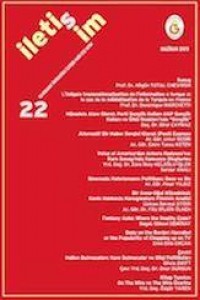Abstract
This study will examine Woody Allen’s The Purple Rose Of Cairo (1985) in the context of the placement of its main character, Cecilia, between the worlds of ‘reality’ and ‘fantasy’. Employing the prominent method in the field of film studies, namely that of discourse analysis, this study first will emphasize the distinction between the ‘real’ and the ‘reality’. Second, it will elaborate the historical, cultural, economical and social circumstances that structure the ‘reality’ of Cecilia’s life. Then, it will question the effects of Hollywood Industry on the spectatorship of women. Lastly, it will describe how Cecilia constructs her own ‘reality’ through the fantasies her mind produces; and in conclusion this study will answer the title question as “reality ends in film theaters since films take the spectators to the worlds of fantasy, at the same time a new reality begins in film theaters since the spectators carry that fantasy into each moment of life as Cecilia does”.
keywords: The Purple Rose of Cairo, reality, fantasy, alienation, female spectatorship
References
- ALLEN Woody and BJORKMAN Stig (2005), “The Purple Rose of Cairo”, Woody
- Allen on Woody Allen, Grove Press, pp. 148-152. BELSEY Catherine (2005), “What’s Real?”, Culture and the Real: Theorizing
- Cultural Criticism, Routledge, pp. 1-19. GIRGUS Sam B. (2002), “The Purple Rose of Cairo”, The Films of Woody Allen,
- Cambridge University Press, pp. 70-88. HANSEN Miriam (1991), “Introduction: Cinema Spectatorship and Public Life”,
- Babel &Babylon: Spectatorship in American Silent Film, Cambridge, MA: Harvard U.P., pp. 1-19. JACKSON Rosemary (1995), Fantasy, Routledge.
- KANUNGO Rabindra N. (1982), Work Alienation: An Integrative Approach,
- Greenwood Publishing Group. MILLER Toby and STAM Robert (2000), “The Historical Spectator/Audience”,
- Film and Theory: An Anthology, Oxford: Blackwell, pp. 337-344. STACEY Jackie (2003), “Star Gazing: Hollywood Cinema and Female
- Spectatorship”, The Audience Studies Reader, edited by Will Brooker and Deborah Jermyn, Routledge, pp. 150-158. WITKIN Robert W. (2003), “Woody Allen’s Culture Industry”, Adorno on
- Popular Culture, Routledge, pp. 151-169.
Abstract
This study will examine Woody Allen’s The Purple Rose Of Cairo (1985) in the context of the placement of its main character, Cecilia, between the worlds of ‘reality’ and ‘fantasy’. Employing the prominent method in the field of film studies, namely that of discourse analysis, this study first will emphasize the distinction between the ‘real’ and the ‘reality’. Second, it will elaborate the historical, cultural, economical and social circumstances that structure the ‘reality’ of Cecilia’s life. Then, it will question the effects of Hollywood Industry on the spectatorship of women. Lastly, it will describe how Cecilia constructs her own ‘reality’ through the fantasies her mind produces; and in conclusion this study will answer the title question as “reality ends in film theaters since films take the spectators to the worlds of fantasy, at the same time a new reality begins in film theaters since the spectators carry that fantasy into each moment of life as Cecilia does”
References
- ALLEN Woody and BJORKMAN Stig (2005), “The Purple Rose of Cairo”, Woody
- Allen on Woody Allen, Grove Press, pp. 148-152. BELSEY Catherine (2005), “What’s Real?”, Culture and the Real: Theorizing
- Cultural Criticism, Routledge, pp. 1-19. GIRGUS Sam B. (2002), “The Purple Rose of Cairo”, The Films of Woody Allen,
- Cambridge University Press, pp. 70-88. HANSEN Miriam (1991), “Introduction: Cinema Spectatorship and Public Life”,
- Babel &Babylon: Spectatorship in American Silent Film, Cambridge, MA: Harvard U.P., pp. 1-19. JACKSON Rosemary (1995), Fantasy, Routledge.
- KANUNGO Rabindra N. (1982), Work Alienation: An Integrative Approach,
- Greenwood Publishing Group. MILLER Toby and STAM Robert (2000), “The Historical Spectator/Audience”,
- Film and Theory: An Anthology, Oxford: Blackwell, pp. 337-344. STACEY Jackie (2003), “Star Gazing: Hollywood Cinema and Female
- Spectatorship”, The Audience Studies Reader, edited by Will Brooker and Deborah Jermyn, Routledge, pp. 150-158. WITKIN Robert W. (2003), “Woody Allen’s Culture Industry”, Adorno on
- Popular Culture, Routledge, pp. 151-169.
Details
| Primary Language | English |
|---|---|
| Journal Section | Articles |
| Authors | |
| Publication Date | August 26, 2015 |
| Published in Issue | Year 2015 Issue: 22 |



